I built this cannon for a science fair project because I bet my biology teacher I could break the speed of sound with a potato (I already knew it had been proven, but he didn't). Anways, I named it FEAR mostly because everyone who has seen it says that they are now afraid of me, so i decided to give it an appropiate name.
It took close to three months of research, designing (in english class), and actual construction, and is the most powerful cannon i have ever built.
As a side note, trying to make good sealing welds with a MIG welder was rather hard, so my dad suggested i grind down the welds till they were smooth and then apply some sort of sealant to seal any gaps. I went one step further and apllied a vacum to the combustion chamber and then applied my sealent (which was seal-all, very nice stuff). Worked perfectly and haven't had a leak since.
Also,
I want to thank my dad, Nathan, for helping me seal my welds (did much of the grinding after I became to tired to safely do it myself), my best friend, Colton, who helped me set up, build, and buy many of the parts, and I would like to thank my mom, Anne, who restrained from banning me from ever building another cannon at my house again, and who also along with my dad funded part of this project.
Anyways, the cannon...
Combustion Chamber
6" diameter sch 40 steel pipe, 63" long. Recomended working pressure 650 psi at 400 F, burst pressure 1100 psi. Total volume approximatly 1809 cubic inchs (includes fittings and such).
Barrel
2"diameter sch 40 PVC pipe, 50 feet long. Seperated in 10' sections and connected together by modify couplings. Total volume approximatly 1884 cubic inches.
Ignition Source
Two car igniton coils connected in parrallel, which have a capacitor from a camera flash circuit discharged into them. The flash from the camera circuit is used as the switch to complete the connection between the capacitor and the igniton coils. This set up is able to produce approximatly 50,000 volts.
This is connected to a spark strip with 5 gaps, each one foot apart, evenly spread through the combustion chamber. These are mounted to a 1/4" steel rod which is mounted to a stainless steel 1" threaded plug and is screwed into 1" tee mounted on combustion chamber.
Burst Disk Set Up
A modified 2" steel coupling is bolted down with 4-1/2" steel bolts onto a piece of 2" sch 80 steel pipe welded to combustion chamber. Burst disks consist of 3 layers of duct tape with a piece of 1/4" plywood cut to fit over the duct tap. Other disks include layers of duct tape and pvc tape, duct tape and aluminum foil, and duct tape and pieces of tin cans (cut to fit).
Features
Air and fuel metering completly controled electonically by operator; Fuel, Vent and Arm switches all have safety covers to prevent accidental switching.
Large size allows more forgiveness when mistakes are made when adding air or fuel to cannon.
Able to achieve velocities up to 2700 fps with a potato (still currently being debated).
All parts on combustion chamber rated to a minimum of 1000 psi.
Total Cost and Time Spent
$20 dollars for combustion chamber
$350 for valves, gauges, all fittings, pipe and barrel
$100 for electonics and parts for control panel
$100 for other stuff.
Total:$570
Spent over 100 hours welding, manufacturing parts, and putting everything together.
The only current pic of FEAR assembled. (I apologize for lack of size and clarity, it was taken with a cell phone).
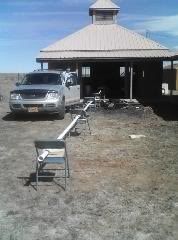
The fuel/air metering system. Consists of 3 valves, two of which are
three-way valves (for the fuel meter and compressed air) and the one-way valve is for venting.
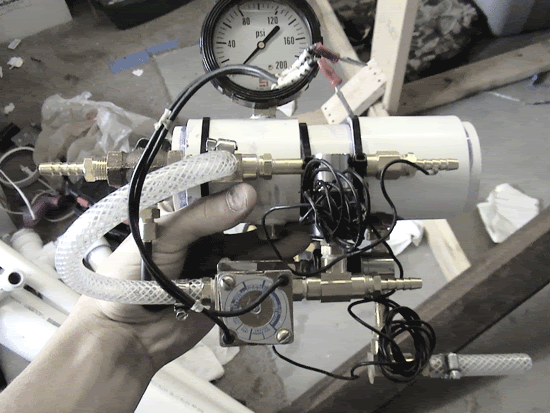
The control panel (back and front). Propane regulator and air compresser gauge are mounted on the panel. The three top switches are (in order from left to right): vent, fuel, and compressed air. All valves work off of 24 volts.
The toggle switch on the bottom is for arming and charging the capacitor, and the pushbutton is for firing the cannon (discharging capacitor into igniton coils)
The control panel consists of a 3/16" thick steel plate, and has the labels for each switch stamped into the metal (sorry, the labels didn't get picked up by the camera).

The main combustion chamber with everything mounted to it. Weighs close to 300 pounds.
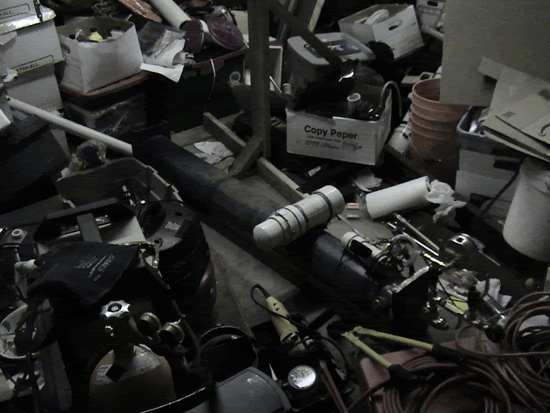
The burst disk holder.
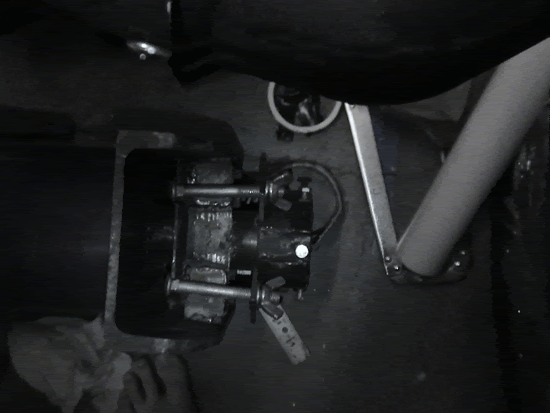
The back of the combustion chamber. The large gauge is a 1-100 psi guage with 1 psi incrments, and is for measuring the correct amount of compressed air; the small guage is for measure the combustion pressure and goes up to 1000 psi (a check valve is used to retain the pressure after the burst disk has burst).
The 1" tee is connected to a 1" sch 80 steel pipe nipple welded to the 3/4" steel plate. This allows the spark strip to be slid in to the combustion chamber (and be located in the center) as well as the fuel and air to be put in. This design allows only 2 holes total in the combustion chamber, one for the spark strip, fuel, and air; and one for the barrel.
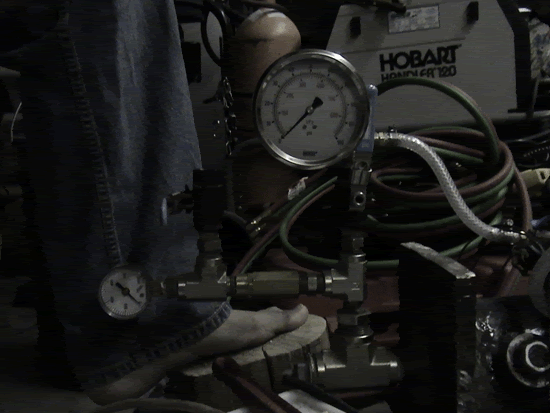
Damage to a 55 gallon drum using 2 golfballs as projectiles. The top of the drum is 3/16" thick steel.

Videos
Potato being fired at sheet metal (wood stopped penetration).

Two loosly wadded golfballs being fired at a steel drum (damage pic above).










